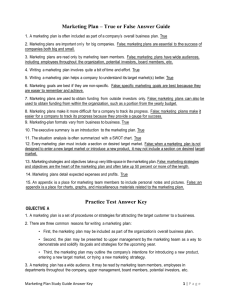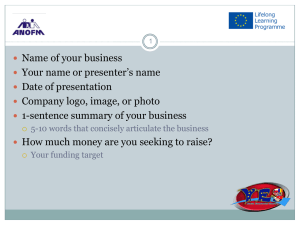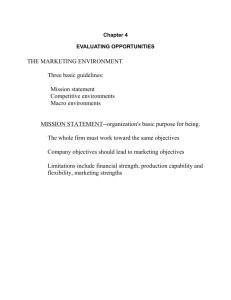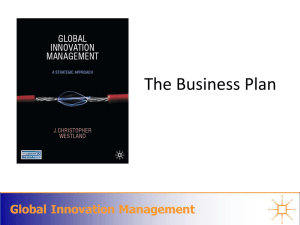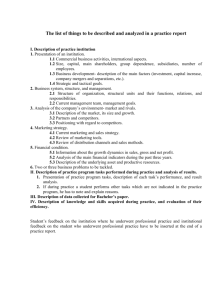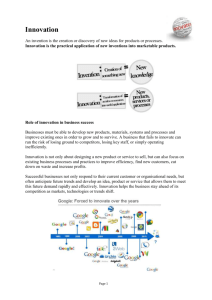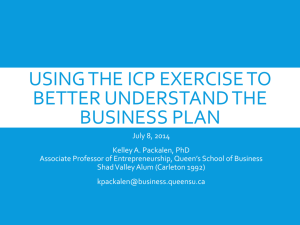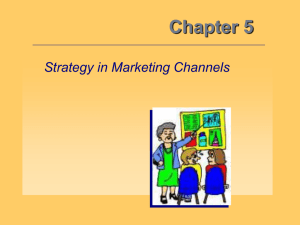Business Plan Guide: Executive Summary, Marketing, Management
advertisement
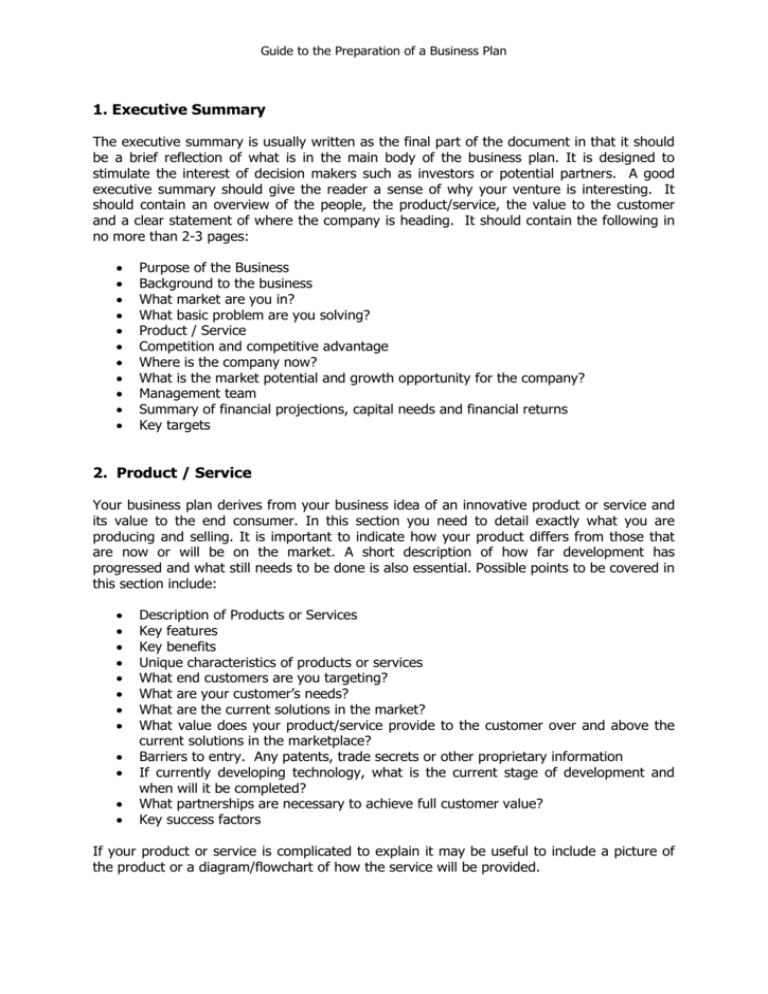
Guide to the Preparation of a Business Plan 1. Executive Summary The executive summary is usually written as the final part of the document in that it should be a brief reflection of what is in the main body of the business plan. It is designed to stimulate the interest of decision makers such as investors or potential partners. A good executive summary should give the reader a sense of why your venture is interesting. It should contain an overview of the people, the product/service, the value to the customer and a clear statement of where the company is heading. It should contain the following in no more than 2-3 pages: Purpose of the Business Background to the business What market are you in? What basic problem are you solving? Product / Service Competition and competitive advantage Where is the company now? What is the market potential and growth opportunity for the company? Management team Summary of financial projections, capital needs and financial returns Key targets 2. Product / Service Your business plan derives from your business idea of an innovative product or service and its value to the end consumer. In this section you need to detail exactly what you are producing and selling. It is important to indicate how your product differs from those that are now or will be on the market. A short description of how far development has progressed and what still needs to be done is also essential. Possible points to be covered in this section include: Description of Products or Services Key features Key benefits Unique characteristics of products or services What end customers are you targeting? What are your customer’s needs? What are the current solutions in the market? What value does your product/service provide to the customer over and above the current solutions in the marketplace? Barriers to entry. Any patents, trade secrets or other proprietary information If currently developing technology, what is the current stage of development and when will it be completed? What partnerships are necessary to achieve full customer value? Key success factors If your product or service is complicated to explain it may be useful to include a picture of the product or a diagram/flowchart of how the service will be provided. Guide to the Preparation of a Business Plan 3. Management Team The management section is often the first part of the plan that investors turn to after reading the executive summary. They want to know whether the management team is capable of running a promising business. When discussing management’s qualifications/experience, be sure to emphasise those that are particularly important for implementing your specific plans. Explain how the responsibilities in the company are to be delegated and indicate which positions still require re-inforcement. Who are the members of your management team? What role will each play? List professional experience / qualifications and link with your product/service concept What experience or abilities are lacking? How will the gaps be closed? List the advisors to the company, i.e. Legal, Financial, Business advisors etc. 4. Markets and Competition A thorough understanding of your customers and their needs is the foundation of every successful business. Only those customers who are convinced they are getting greater value than they would from a competing product, or by not buying a product or service at all, will buy your product. Knowing your market and competition well is thus critical to the success of your undertaking. In this section you should include: Definition of your market. Who, what, where, when, how much? Market size i.e. o Number of customers o Unit sales o Value € in sales Market Growth Main factors influencing the industry The above information can be obtained from many sources including trade literature, industry directories, associations and government agencies. Many of these sources are now online through the Internet. Another great source of information is interviews with industry/sector experts and advisors to the industry such as consultants and government agency advisors. In developing the plan it is important to reference any third party material so that information can be verified. Market Segmentation (Target Groups) Follow up your explanation of the general market with a description of the segments within that market you intend to target, i.e. who is my product or service meant for? The choice of segmentation criteria is up to you, as long as you are certain that the number of customers in each segment – as well as their behaviour – can be determined, and that customers within each segment can be reached by means of the same marketing strategy. A target group has a number of features in common for example: Guide to the Preparation of a Business Plan Location: Country, Urban/rural, area of residence Demographics: Age, sex, income, marital status Lifestyle: e.g. Techies, Active seniors, Crazy Kids Buying habits: e.g. Vegetarians, price conscious shoppers Occupation Situational factor: Urgency of need, convenience, order size Competition A competitor is a business that provides the same goods and services as yours (Direct competitors) – or an alternative (indirect competitors). Think about who your competitors are and describe them. What are the alternatives to your product/service? Are there any barriers to market entry? Who are the competitors, how many are there and where are they located? How does the competition operate? What choices do they offer customers? What target groups do your competitors address? How strong are your competitors? What is their likely reaction to a new entrant? What are the current strengths and weaknesses of your competitors? What will be your competitive edge over your competition? What competition might you face that you have not yet encountered? Unique Selling Proposition You have identified your competition, their strengths and weaknesses and practices. You now need to ask yourself why should a potential customer buy your product or service and not that of your competitor. Because it offers greater value (in some aspect that is important to the customer) than competing products; because it is objectively or emotionally “better”, or you have developed a value proposition or Unique selling proposition for your business idea. Guide to the Preparation of a Business Plan 5. Marketing and Sales Key elements of a well-conceived business concept are well-planned marketing and sales activities. They require a persuasive description of your strategies for market launch, marketing, and the measures planned for sales promotion. A good tool to use is the four ‘P’ framework which is detailed below. Product What product attributes / service benefits are important to the customer? What makes your product / service different to the competition? What products/services are targeted at different segments? How important is service, warranty, after sales service etc? Is there a need for product variation/ / product line? How important is packaging? What are the complementary products/services associated with your product/service? Place (Sometimes described as distribution but in the case of services the actual place of business) Via which distribution channel, do you want to deliver your product? How will they be targeted and what will be their motivation to sell your product? What profit margin will they require? What support structure must you put in place in order to get the product to distributors? What will the customer see and experience when he or she visits your business? What physical signage is appropriate to identify your service? Price Establish what your customers are going to pay for your product or service? How important is price to the buyer? What Margins (Profits) will you make after immediate production and after you factor in profits for your distributors and your marketing expenditure? If you have a range of products or services, how should they be priced relative to each other and to their competition? What discounts/special offers can you implement in order to enter the market while still making a profit? How should you react to a competitive price threat? Promotion How are do you make potential customers aware of your product / service? o Classic advertising: Newspapers, trade journals, Yellow Pages, TV o Direct marketing: Direct mail to select customers, telephone marketing o Public relations: Articles in print media about your product / service o Exhibitions, Trade fairs o Personal selling: Direct visits to customers o Internet: On-line selling, e-mail marketing What budget will provide you with the maximum exposure to your target market? *Note some commentators use two further ‘P’s, Personnel and Presentation. Guide to the Preparation of a Business Plan 6. Business System and Organisation (Operations) In order to get your finished product or service to the end customer a number of activities must take place, e.g. sourcing raw materials, manufacturing, staffing, distribution etc. Devising a business system, ‘How things work’ is a good way to understand the business activities of a company and how they interplay with each other. Together with your team, think carefully about what activities really create something new and how you and your staff can best make use of your time to create the highest value for your customer and get ahead of the competition. What does the business system for your product / service look like? Map out the flow of how you get from raw material to end customer Detail the physical aspects of your manufacture / service e.g. premises, warehouse, retail unit etc. What capacity for product manufacture and service production do you plan? Give details of your raw materials and your suppliers What activities do you want to handle yourself? What can you get other companies to do for you? How dependent are you on these third parties? Where will the focus of your own activities lie? What business functions make up your organisation, and how is it structured? What resources / assets do you need to create your products / service? How are your costs structured? 7. Implementation Schedule You and potential investors need to know how you envision the development of your business. A realistic plan will inspire credibility among investors and business partners. Moreover, it will help you think through your various activities and interdependencies. You will endanger your business if you attempt to reach your targets with faulty and, above all, overly optimistic planning, your schedule should include: What are the most important milestones for the development of your business, and when must they be reached? How do you plan to structure the work to reach these targets? Which tasks and milestones are interdependent? Where do you anticipate bottlenecks? What assets will you need to start-up the organisation? Give details of projected employments by sector i.e. skilled, administration, sales etc. List the investments you may require in the short / medium and long term Guide to the Preparation of a Business Plan 8. Opportunities and Risks The object of this exercise is to identify a margin of error for departures from your assumptions. If possible, with reasonable effort, it is advisable to draw up best-case and worst-case scenarios involving key parameters to identify the opportunities and risks. These calculations will allow investors and business partners judge how realistic your plans are, and to better assess the risk of their investment. Questions to answer include: What basic risks (market, competition, technology) does your business venture face? What measures will you take to counter these risks? What extraordinary opportunities/business possibilities do you see for your company? What are the financial implications? 9. Financial Planning and Financing Financial planning assists you in evaluating whether your business concept will be profitable and can be financed. To this end the results of all the preceding sections must be compiled and consolidated. Points discussed in the marketing plan such as projected sales should be reflected in the profit and loss account marketing mix costs and employment costs should also be included. Several statements in this section are necessary for some companies according to commercial and tax law. The financial element of the plan consists of: The investment plan – What you need to get started? The profit and loss forecasts – How the operations of the company will generate sales and at what cost? The liquidity or cash flow forecast – How cash will be used in the running of the business. The income and expenditure of the business When developing the above financial statements the following points should be kept in mind How will your revenues, expenses, and income develop? How will your cash flow develop? What assumptions underlie your financial planning? How high is your need for financing? Which sources of capital are available to you to cover your financial needs? What government grants are available to organisations like your own? What return on investment can investors expect and when can they expect to make a profit?
